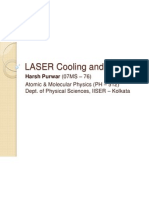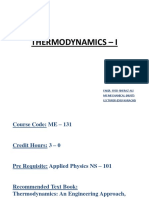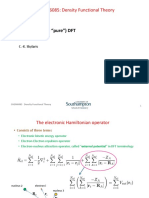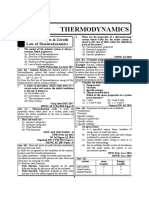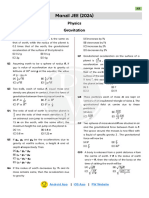TD Pyqs & NTPP - 3 (22.06.23)
TD Pyqs & NTPP - 3 (22.06.23)
Uploaded by
jieus parloCopyright:
Available Formats
TD Pyqs & NTPP - 3 (22.06.23)
TD Pyqs & NTPP - 3 (22.06.23)
Uploaded by
jieus parloOriginal Title
Copyright
Available Formats
Share this document
Did you find this document useful?
Is this content inappropriate?
Copyright:
Available Formats
TD Pyqs & NTPP - 3 (22.06.23)
TD Pyqs & NTPP - 3 (22.06.23)
Uploaded by
jieus parloCopyright:
Available Formats
Basic Thermodynamics by NEGI10 PYQs - 03
Chapter : Basic Concepts
Topic : Property
1. [MCQ, ] 5. [MCQ, ]
Which one of the following is an intensive property of Identify the group containing the appropriate match
a thermodynamic system? of items in List-I and List-II.
A. Mass B. Density
C. Energy D. Volume List-I
0 de
[GATE-2022-ME:1M] K-A jet engine in flight
L-Water being heated in a sealed container
2. [MCQ, ] M-Internal energy
Which of the following is an intensive thermodynamic N-Specific entropy
I1 o
property? List-II
A. Enthalpy B. Internal energy
C.Entropy c D. Pressure
[GATE-2019-XE:1M]
P-Closed system
Q-Control volume
R-Intensive property
EG al
S-Extensive property
3. [MCQ, ] A. K-P; L-Q; M-R; N-S
Consider the following properties: B. K-Q; L-P; M-R; N-S
N rr
(P) temperature C. K-Q; L-P; M-S; N-R
(Q) specific gravity D. K-P; L-Q; M-S; N-R
[GATE-2011-XE:1M]
e
(R) chemical potential
(S) volume
ef
The option which lists ALL the intensive properties is 6. [MCQ, ]
A. P B. P and Q Intensive thermodynamic variables are
C. P, Q and R D. P, Q, R and S A. independent of the number of moles in the system
R
[GATE-2017-CH:1M] B. dependent on the volume of the system
C. dependent on the mass of the system
4. [MCQ, ] D. independent of the temperature of the system.
Which of the following thermodynamic properties is [GATE-2009-MT:1M]
NOT an intensive property of a thermodynamic
system: 7. [MCQ, ]
A. Pressure B. Temperature A system is partitioned into two equal parts. An
C. Density D. Volume intensive property of each part will
[GATE-2016-XE:1M] A. become half
B. remains unchanged
C. double
D. depend on the nature of the intensive property
[GATE-2007-XE:1M]
WhatsApp NEGI SIR, AIR –I 8341320644, 8292244719
Answer Key
1. (B) 5. (C)
2. (D) 6. (A)
3. (C) 7. (B)
4. (D)
0 de
I1 o
c
EG al
N rre
ef
R
WhatsApp NEGI SIR, AIR- I 8341320644, 8292244719
Hints & Solutions
1. Answer: (B) (B) Water heated in sealed container
Sol.
Intensive properties: Density, temperature chemical
potential and specific gravity.
Extensive properties: Mass, Energy and Volume.
2. Answer: (D) (C) Internal Energy Extensive Property
Sol.
Pressure is an intensive property while Enthalpy, (D) Specific Entropy Intensive Property
Internal Energy & Entropy are extensive properties.
0 de
6. Answer: (A)
3. Answer: (C) Sol.
Sol. Intensive thermodynamic variables are independent
Temperature, specific gravity and chemical potential of the extent (size) of the system.
I1 o
are the intensive properties. ⇒ Independent of No. of moles of the
Volume is an extensive property.
4. Answer: (D)
c 7. Answer: (B)
Sol.
EG al
Sol.
Volume is an extensive property.
N rr
5. Answer: (C)
If ‘B’ is an intensive property, then it is
Sol.
independent of extent of the system.
(A) Jet engine in flight
e
ef
R
WhatsApp NEGI SIR, AIR- I 8341320644, 8292244719
Basic Thermodynamics by NEGI10 NTPP - 03
Chapter : Basic Concepts
Topic : Property
1. [MSQ, ] 4. viscosity
Control volume in a thermodynamic system 5. chemical potential
refers to 6. magnetization
0 de
A. a control volume can be fixed in size and shape 7. pressure
B. a control volume can involve energy 8. thermal conductivity
interactions but doesn’t involve any mass 9. specific entropy
interactions. 10. enthalpy
I1 o
C. a control volume can’t involve any energy
[MCQ, ]
c
interactions but involve mass interactions.
D. in addition to mass interaction, control volume
can involve energy interactions also.
5.
Which of the following statement(s) is/are
incorrect?
EG al
A. ratio of two extensive properties is an
2. [MCQ, ] intensive property.
N rr
The value of an extensive property is essentially B. specific properties are the extensive properties
depends on per unit mass.
A. nature of boundaries. C. extensive properties are additive in nature.
e
B. the size of the system. D. intensive properties are additive in nature
ef
C. energy interactions with system and its
surroundings 6. [NAT, ]
D. the immediate surrounding of a thermo How many of the given properties are extensive
R
dynamic system properties ______ (in Integer).
1. mass
3. [MCQ, ] 2. volume
Which of the following is an extensive property? 3. internal energy
A. density B. pressure 4. enthalpy
C. volume D. temperature 5. specific entropy
6. electric charge
4. [NAT, ] 7. temperature
The number of Intensive properties in the 8. velocity
following list is ____ (in integer)
9. entropy
1. velocity
10. specific volume
2. electric charge
11. density
3. volume
WhatsApp NEGI SIR, AIR – I 8341320644, 8292244719
Answer Key
1. (A, D) 4. (6 to 6)
2. (B) 5. (D)
3. (C) 6. (6 to 6)
0 de
I1 o
c
EG al
N rre
ef
R
WhatsApp NEGI SIR, AIR – I 8341320644, 8292244719
Hints & Solutions
1. Answer: (A, D) 8. thermal conductivity → Intensive
Sol. 9. specific entropy → Intensive
A control volume can be fixed in size and shape. 10. enthalpy → Extensive
A control volume can involve energy interactions
& mass interactions. 5. Answer: (D)
Sol.
2. Answer: (B) Ratio of two extensive properties is an intensive
Sol. property
The value of an extensive property depends on
0 de
Specific properties are the extensive properties
size of the system. per unit mass
Extensive properties are additive in nature
3. Answer: (C) E = EI + EII + EIII
I1 o
Sol.
Density → Intensive 6. Answer: (6 to 6)
Pressure → Intensive
Volume → Extensive c
Temperature → Intensive
Sol.
1. mass → Extensive
EG al
2. volume → Extensive
3. internal energy → Extensive
4. Answer: (6 to 6)
4. enthalpy → Extensive
N rr
Sol.
1. velocity → Intensive 5. specific entropy → Intensive
2. electric charge → Extensive 6. electric charge → Extensive
e
3. volume → Extensive 7. temperature → Intensive
ef
4. viscosity → Intensive 8. velocity → Intensive
5. chemical potential → Intensive 9. entropy → Extensive
6. magnetization → Extensive 10. specific volume → Intensive
R
7. pressure → Intensive 11. density → Intensive
WhatsApp NEGI SIR, AIR – I 8341320644, 8292244719
1
Basic Thermodynamics by NEGI10 NTPP - 02
Chapter : Basic Concepts
Topic : Types of Systems
1. [MCQ, ] A. mass does not cross boundaries of the system,
For an insulated system though energy may do so
A. all Energy interactions must be zero B. mass crosses the boundary but not the energy
B. heat interactions can take place C. neither mass nor energy crosses the
C. work interactions can take place boundaries of the system
0 de
D. neither heat interaction nor work interaction D. both energy and mass cross the boundaries of
can take place the system
I1 o
2. [MCQ, ] 5. [MCQ, ]
A system is considered as open system when An open system
c
A. heat and work interactions can cross the
boundary but not the mass of the working
A. is a specified region where transfers of energy
and/or mass take place
B. is a region of constant mass and only energy is
EG al
substance
B. mass of working substance can cross the allowed to cross the boundaries
boundary but not heat and work C. cannot transfer either energy or mass to or
N rr
C. neither heat and work interactions nor mass of from the surroundings
the working substance can cross the boundary D. has an enthalpy transfer across its boundaries
e
and the mass within the system is not
D. both the heat and work interactions as well as
necessarily constant
mass of the working substances can cross the
ef
boundary
6. [MCQ, ]
Identify open system and closed system from the
3. [MCQ, ]
R
following
An isolated system
A. Blood circulation and respiration in human
A. is a specified region where transfer of energy
body
and/or mass take place
B. Fuel system and radiator in cars
B. is a region of constant mass and only energy is
C. Air compressor and boiler
allowed to cross the boundaries
D. Shell and tube heat exchanger and blower
C. cannot transfer either energy or mass to or
from the surroundings
7. [MCQ, ]
D. none of the above
Which of the following represents a closed
system?
4. [MCQ, ]
A. Bomb calorimeter B. Boiler
A closed system is one in which:
C. Universe D. Centrifugal pump
WhatsApp NEGI SIR, AIR - I 8341320644, 8292244719
Answer Key
1. (C) 5. (A)
2. (D) 6. (C)
3. (C) 7. (A)
4. (A)
0 de
I1 o
c
EG al
N rre
ef
R
WhatsApp NEGI SIR, AIR - I 8341320644, 8292244719
Hints & Solutions
1. Answer: (C) 4. Answer: (A)
Sol. Sol.
For insulated system, heat interaction is zero mass does not cross boundaries of the system,
but work interactions can take place. though energy may do so
2. Answer: (D) 5. Answer: (A)
Sol. Sol.
A system is considered as open system when is a specified region where transfers of energy
both the heat and work interactions as well as and/or mass take place
0 de
mass of the working substances can cross the
boundary 6. Answer: (C)
Sol.
3. Answer: (C) Air compressor and boiler
I1 o
Sol.
cannot transfer either energy or mass to or 7. Answer: (A)
c
from the surroundings Sol.
Bomb calorimeter
EG al
N rre
ef
R
WhatsApp NEGI SIR, AIR - I 8341320644, 8292244719
Basic Thermodynamics by NEGI10 PYQs - 01
Chapter : Basic Concepts
Topic : System and Surrounding
1. [MCQ, ] 4. No chemical reaction takes place within the
An isolated thermodynamic system executes a system
process. Choose the correct statement (s) from A. 1 & 2 B. 1, 2 & 3
0 de
the following? C. 1, 2, 3, 4 D. None of these
1. No heat is transferred [GATE-1999-ME:2M]
2. No work is done
I1 o
3. No mass flows across the boundary of the
system
c
EG al
N rre
ef
R
WhatsApp NEGI SIR, AIR – I 8341320644, 8292244719
0 de
I1 o
c
EG al
N rre
ef
R
WhatsApp NEGI SIR, AIR – 1 8341320644, 8292244719
Answer Key
1. (B)
0 de
I1 o
c
EG al
N rre
ef
R
WhatsApp NEGI SIR, AIR – 1 8341320644, 8292244719
Hints & Solutions
1. Answer: (B) In Isolated system energy transfer can’t take
Sol. place but energy transformation can take place.
Isolated system is the system in which neither Hence in Isolated system chemical reaction can
mass nor energy interactions can take place. take place within the system.
0 de
I1 o
c
EG al
N rre
ef
R
WhatsApp NEGI SIR, AIR – 1 8341320644, 8292244719
Basic Thermodynamics by NEGI10 NTPP - 01
Chapter : Basic Concepts
Topic : System and Surrounding
1. [MCQ, ] C. neither heat and work interactions nor mass of
0 de
A fixed quantity of matter or a region in space the working substances can cross the
chosen for study is known as boundary
A. thermodynamic cycle D. both the heat and work interactions as well as
B. thermodynamic system mass of the working substances can cross the
I1 o
C. thermodynamic process boundary
D. thermodynamic law
2. [MCQ, ]
c 5. [MSQ, ]
For a closed system having all rigid or fixed
boundaries, choose the correct statements.
EG al
Anything external to the system is known as
A. mass interactions can take place.
A. boundary
B.displacement work is zero.
B. universe
N rr
C. energy interactions can take place.
C. surrounding
D. heat interaction is zero
D. container
e
6. [MCQ, ]
3. [MCQ, ] Pickup the correct one regarding closed system
ef
Choose the incorrect statement for system A. mass of the working substance can cross the
boundary boundary.
A. boundary is interface shared by system and
R
B. energy interactions can cross the boundary
surrounding. C. the volume of a closed system is fixed.
B. thickness of boundary is zero D. control mass approach doesn’t have any
C. boundary can be fixed or flexible relation with closed system.
D. boundary can be real but not imaginary
7. [MCQ, ]
4. [MCQ, ] For an isolated system, choose the correct one.
A system is considered as closed system when A. mass interactions can’t take place but energy
A. heat and work interactions can cross the interactions can take place.
boundary but not the mass of the working B. mass interactions can take place but energy
substance interactions can’t take place.
B. mass of working substance can cross the C. energy transformation can take place.
boundary but not heat and work
WhatsApp NEGI SIR, AIR - I 8341320644, 8292244719
D. neither energy interactions nor energy A. heat and work interactions can cross the
transformation can take place. boundary but not the mass of the working
substance
8. [MCQ, ] B. mass of working substance can cross the
For an insulated system boundary but not heat and work
A. all Energy interactions must be zero C. neither heat and work interactions nor mass of
B. heat interactions can take place the working substance can cross the boundary
C. work interactions can take place D. both the heat and work interactions as well as
D. neither heat interaction nor work interaction mass of the working substances can cross the
can take place boundary
0 de
9. [MCQ, ]
A system is considered as open system when
I1 o
c
EG al
N rre
ef
R
WhatsApp NEGI SIR, AIR - I 8341320644, 8292244719
Answer Key
1. (B) 6. (B)
2. (C) 7. (C)
3. (D) 8. (C)
4. (A) 9. ( 𝐃)
5. (B, C) 10. (A,D)
0 de
I1 o
c
EG al
N rre
ef
R
WhatsApp NEGI SIR, AIR - I 8341320644, 8292244719
Hints & Solutions
1. Answer: (B) So heat interactions can take place.
Sol. For the closed system with fixed boundaries
A fixed quantity of matter or a region in space displacement work is zero.
chosen for study is known as system.
6. Answer: (B)
2. Answer: (C) Sol.
Sol. For a closed system, energy interactions can
Anything external to the system is known as cross the boundary.
0 de
surrounding.
7. Answer: (C)
3. Answer: (D) Sol.
Sol. For Isolated system, energy transfer can’t take
I1 o
Boundary can be real or imaginary. place but energy transformation can take place.
Boundary can be rigid (fixed) or flexible
4.
(movable).
Answer: (A)
c 8. Answer: (C)
Sol.
For insulated system, heat interaction is zero
EG al
Sol. but work interactions can take place.
Closed system is the system in which mass
N rr
interactions can’t take place but energy 9. Answer: (D)
interactions can take place. Sol.
A system is considered as open system when
e
5. Answer: (B, C) both the heat and work interactions as well as
ef
Sol. mass of the working substances can cross the
For a closed system, mass interactions can’t boundary
take place but energy interactions can take
R
place.
WhatsApp NEGI SIR, AIR - I 8341320644, 8292244719
You might also like
- FM NTPP PYQs - 59 01.12.23 1701610516633Document691 pagesFM NTPP PYQs - 59 01.12.23 1701610516633helalNo ratings yet
- Chapter 5 Energy Storage ElementsDocument11 pagesChapter 5 Energy Storage ElementsAkmal Hakim Bin IdrisNo ratings yet
- MCQs FirstyearDocument38 pagesMCQs FirstyearÂfñåņ AhmedNo ratings yet
- 1487251639EE 2017 - Session 1 (Kreatryx Solutions)Document40 pages1487251639EE 2017 - Session 1 (Kreatryx Solutions)Utkarsh RajNo ratings yet
- School of Engineering Department of Mechanical EngineeringDocument17 pagesSchool of Engineering Department of Mechanical EngineeringMohammed KawashNo ratings yet
- LASER Cooling and Trapping of AtomsDocument20 pagesLASER Cooling and Trapping of AtomsHarsh Purwar100% (1)
- Iraqi Specifications Sampling Procedure 2011Document53 pagesIraqi Specifications Sampling Procedure 2011Mohammed Al-Ani88% (16)
- Tutorial Answers - Separation B Tutorial - Combined Tutorial Solutions PDFDocument38 pagesTutorial Answers - Separation B Tutorial - Combined Tutorial Solutions PDFBuyuNo ratings yet
- Chemistry Ecet by AdithyaDocument125 pagesChemistry Ecet by AdithyaKUNUSOTH SAIKUMAR0% (1)
- Kreatryx Digital PDFDocument48 pagesKreatryx Digital PDFsrinuNo ratings yet
- Objective Type Questions Instrumentation System & Devices (IDS)Document7 pagesObjective Type Questions Instrumentation System & Devices (IDS)mail2jaleel9952No ratings yet
- Work Power Energy Faculty Copy Yw3bPNODocument92 pagesWork Power Energy Faculty Copy Yw3bPNOSamridh GuptaNo ratings yet
- ECalc - XcopterCalc - The Most Reliable Multicopter Calculator On The WebDocument3 pagesECalc - XcopterCalc - The Most Reliable Multicopter Calculator On The WebJeferson Mellado TraipeNo ratings yet
- Solar CellDocument27 pagesSolar CellShika BuNo ratings yet
- M Tech MicroelectronicsDocument11 pagesM Tech MicroelectronicsneetubansalNo ratings yet
- PHYSICS 12th Sci Prelim Question PaperDocument4 pagesPHYSICS 12th Sci Prelim Question PaperAditya Deshmukh0% (1)
- Transfer Function To State Space and Vice Versa PDFDocument10 pagesTransfer Function To State Space and Vice Versa PDFMudassar Khalid100% (1)
- PSA Paramount (EE) + FrontDocument92 pagesPSA Paramount (EE) + FrontAkhilesh MauryaNo ratings yet
- 10 - 05 - 2022 PH3259 Set-ADocument2 pages10 - 05 - 2022 PH3259 Set-Aohmshankar100% (1)
- Thermodynamics - I: Engr. Syed Sheraz Ali Ms Mechanical (Nust) Lecturer (Dsu Karachi)Document47 pagesThermodynamics - I: Engr. Syed Sheraz Ali Ms Mechanical (Nust) Lecturer (Dsu Karachi)أبو أسامة حمدي100% (1)
- Principles of Measurement Systems 20051Document1 pagePrinciples of Measurement Systems 20051AadityaSingh0% (3)
- IIT JEE Physics QuestionsDocument11 pagesIIT JEE Physics QuestionsKartikNo ratings yet
- Electrical Machine Paramount (EE) + FrontDocument81 pagesElectrical Machine Paramount (EE) + FrontAkhilesh MauryaNo ratings yet
- 12th Physics Important Long Question by Youth Academy 0346-6116201 PDFDocument5 pages12th Physics Important Long Question by Youth Academy 0346-6116201 PDFhameedtahir000No ratings yet
- DC - Machines - IDocument23 pagesDC - Machines - IKevinXavierNo ratings yet
- Chapter 4 - Second LawDocument32 pagesChapter 4 - Second LawAshok PradhanNo ratings yet
- PH Ysicsguide: MagnetostaticsDocument46 pagesPH Ysicsguide: MagnetostaticsRithish Barath100% (1)
- Chapter Three: Pressure and Fluid StaticsDocument84 pagesChapter Three: Pressure and Fluid Staticsznour alyNo ratings yet
- Fiitjee All India Test Series: JEE (Advanced) - 2020Document16 pagesFiitjee All India Test Series: JEE (Advanced) - 2020Yogesh Kumar PandeyNo ratings yet
- SOLARDocument15 pagesSOLARShubhangi Shivaji Pawar100% (1)
- Control System Paramount (EC-EE) + FrontDocument118 pagesControl System Paramount (EC-EE) + FrontAkhilesh MauryaNo ratings yet
- Overview:: Book Title:-Engineering Physics, 2E Author:-B. K. Pandey - SDocument2 pagesOverview:: Book Title:-Engineering Physics, 2E Author:-B. K. Pandey - Sdamini chandi priyaNo ratings yet
- SOLUTIONSDocument11 pagesSOLUTIONSVijayraj100% (1)
- Iit Jee Screening 2000Document10 pagesIit Jee Screening 2000Ashish535No ratings yet
- Diode CapacitanceDocument13 pagesDiode CapacitanceSuresh Reddy TamanampudiNo ratings yet
- KPCL Ae 2010Document27 pagesKPCL Ae 2010basavarajNo ratings yet
- MAT 2101 Complex Variables, Laplace and Z Transform COURSE OUTLINE Fall 23-24Document7 pagesMAT 2101 Complex Variables, Laplace and Z Transform COURSE OUTLINE Fall 23-24jop23343No ratings yet
- Chemical EngineeringDocument62 pagesChemical Engineeringanchal thapaNo ratings yet
- BITSAT Sample Paper 2022Document264 pagesBITSAT Sample Paper 2022Shristi ChauhanNo ratings yet
- 11th Final PhysicsDocument5 pages11th Final Physicsanand tiwariNo ratings yet
- FM PYQs & NTPP - 15 (03.05.23)Document146 pagesFM PYQs & NTPP - 15 (03.05.23)PAWAN KUMARNo ratings yet
- Mechanics: Mechanics Thermal Physics Waves & Optics Electricity & Magentism Modern PhysicsDocument11 pagesMechanics: Mechanics Thermal Physics Waves & Optics Electricity & Magentism Modern PhysicsTibra ArkaNo ratings yet
- Complex Engineering Problem: Submitted To Sir Umer Hamid Submitted by Hassan (04) Danish (14) SumamaDocument14 pagesComplex Engineering Problem: Submitted To Sir Umer Hamid Submitted by Hassan (04) Danish (14) SumamaUmar HamidNo ratings yet
- Solar Photovoltaics: Fundamentals, Technology and ApplicationsDocument1 pageSolar Photovoltaics: Fundamentals, Technology and ApplicationspksahunitrklNo ratings yet
- chp7 3 Economic Dispatch PDFDocument11 pageschp7 3 Economic Dispatch PDFdo3llah100% (1)
- Mathematics Paramount (EC-EE) + FrontDocument35 pagesMathematics Paramount (EC-EE) + FrontAkhilesh MauryaNo ratings yet
- MP & DSP Lab ManualDocument122 pagesMP & DSP Lab ManualShiva RamNo ratings yet
- PHYS 102 - General Physics II Final Exam Solutions: Duration: 120 Minutes Wednesday, 22 May 2019Document4 pagesPHYS 102 - General Physics II Final Exam Solutions: Duration: 120 Minutes Wednesday, 22 May 2019Serkan Doruk HazinedarNo ratings yet
- State Space Analysis - 2 - DPP-17Document2 pagesState Space Analysis - 2 - DPP-17Vishnu V MNo ratings yet
- Jee-Main - GTM (Only 2nd Yr Syllabus)Document1 pageJee-Main - GTM (Only 2nd Yr Syllabus)Sameena Loni100% (1)
- AddEx Ch5Document4 pagesAddEx Ch5manishNo ratings yet
- PH Ysicsguide: Basic Postulates of QMDocument32 pagesPH Ysicsguide: Basic Postulates of QMRithish Barath100% (1)
- Problems Based On Centre of MassDocument11 pagesProblems Based On Centre of Massrgurvareddy100% (2)
- MechDocument7 pagesMechPradeep KumarNo ratings yet
- HW #1 SolutionsDocument10 pagesHW #1 SolutionsDEEPSNo ratings yet
- Syllabus For B.SC Physics Semester Pattern2013Document23 pagesSyllabus For B.SC Physics Semester Pattern2013GnetTechnologies GondiaNo ratings yet
- DFT L5Document22 pagesDFT L5Ali AhmadaliNo ratings yet
- Basic Concepts Pyqs Qstfc BtdDocument49 pagesBasic Concepts Pyqs Qstfc Btdyogeshmahajan825No ratings yet
- 1.thermal (500+0Document52 pages1.thermal (500+0ajayNo ratings yet
- ThermodynamicsDocument121 pagesThermodynamicsAnonymous TedqS0h6ZkNo ratings yet
- PhysicsDocument46 pagesPhysicsam9812135945No ratings yet
- ThermodyDocument12 pagesThermodyanshwitripathi59No ratings yet
- Unit-1 BuddhismDocument4 pagesUnit-1 Buddhismjieus parloNo ratings yet
- Unit-1 Essence of Indian Traditional KnowledgeDocument3 pagesUnit-1 Essence of Indian Traditional Knowledgejieus parloNo ratings yet
- Unit-1 Vedas, Upanishadas and Yogsutras of PatanjaliDocument4 pagesUnit-1 Vedas, Upanishadas and Yogsutras of Patanjalijieus parloNo ratings yet
- TD Pyqs & NTPP - 2 (20.06.23)Document11 pagesTD Pyqs & NTPP - 2 (20.06.23)jieus parloNo ratings yet
- TD Pyqs & NTPP - 4 (23.06.23)Document23 pagesTD Pyqs & NTPP - 4 (23.06.23)jieus parloNo ratings yet
- 2015 - Kinetic and Modeling Study of The EthyleneDocument13 pages2015 - Kinetic and Modeling Study of The EthylenevictorNo ratings yet
- A Level Physics Data Formulae Relationships PDFDocument8 pagesA Level Physics Data Formulae Relationships PDFD-Cristen OrlandoNo ratings yet
- Impedance and Admittance and PowerDocument35 pagesImpedance and Admittance and PowerSubhadeep BhattacharyaNo ratings yet
- Chapter 8 AssessmentDocument19 pagesChapter 8 AssessmentLeinNo ratings yet
- Band Ura 2002Document6 pagesBand Ura 2002Anonymous 3fztojNo ratings yet
- Tuto 7 Synch GeneratorDocument1 pageTuto 7 Synch GeneratorVievie Le BluewberrietrufflesNo ratings yet
- Fluid Mechanism PDFDocument30 pagesFluid Mechanism PDFEs ENo ratings yet
- Antenna Engineering EC 544: Prof. Darwish Abdel AzizDocument27 pagesAntenna Engineering EC 544: Prof. Darwish Abdel AzizNourhanGamal100% (1)
- Centrifugal ForceDocument2 pagesCentrifugal Forceroma-ibarreta-7565No ratings yet
- Gravitation - Practice SheetDocument8 pagesGravitation - Practice SheetpadhaiionlyNo ratings yet
- Solution - Assignment P BLOCK ELEMENTSDocument4 pagesSolution - Assignment P BLOCK ELEMENTSYash KumarNo ratings yet
- 2010 Fiber Forge Peek UnidirectionalDocument1 page2010 Fiber Forge Peek Unidirectionalmcurtin505No ratings yet
- Physics LabDocument2 pagesPhysics LabDrumz StaffNo ratings yet
- Parallel Operation of GeneratorsDocument6 pagesParallel Operation of GeneratorsKhaldoon AlnashiNo ratings yet
- National Examinations - December 2011: NotesDocument26 pagesNational Examinations - December 2011: NotesNiko Garcia MeythalerNo ratings yet
- Slot WindingDocument22 pagesSlot WindingFitri Senpai80% (5)
- Resistencia Por OlasDocument17 pagesResistencia Por Olasjulianllampi592No ratings yet
- Quad 1Document13 pagesQuad 1prakhartripathi826No ratings yet
- 17C PDFDocument67 pages17C PDFjankimchandra100% (1)
- Particle Interactions 1 - A LevelDocument16 pagesParticle Interactions 1 - A LevelAdebayo WalidNo ratings yet
- Heat 4e Chap07 LectureDocument30 pagesHeat 4e Chap07 LectureDustin White100% (1)
- Hex 17Document8 pagesHex 17PeterWangNo ratings yet
- 1 Principles of Radiation Shielding - Arthur B. Chilton - v2Document212 pages1 Principles of Radiation Shielding - Arthur B. Chilton - v2thadeuhenrique1113No ratings yet
- Multiple Choice QuestionsDocument38 pagesMultiple Choice QuestionsBoo BaNo ratings yet
- Topic 1 - Simple CurvesDocument6 pagesTopic 1 - Simple CurvesNicholas Bonn SingNo ratings yet
- Serway Physics II Example Questions Chapter 7Document1 pageSerway Physics II Example Questions Chapter 7AizuddinNo ratings yet
- Unit 2 Kinematics of Linkage Mechanisms: Absolute and Relative VelocityDocument16 pagesUnit 2 Kinematics of Linkage Mechanisms: Absolute and Relative VelocityEugine BalomagaNo ratings yet





